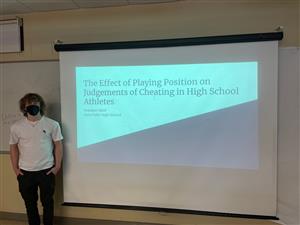-
New Paltz Students Present Projects at Eastern New York Junior Science Symposium

New Paltz High School seniors Lora Johnson and Brandon Sirof, both of Gardiner, recently competed in the Junior Science and Humanities Symposium (JSHS), which took place virtually this year. Lora and Brandon, along with 60 other students from the eastern New York region, presented the results of their own original research investigations.
The JSHS program, which is sponsored by the Departments of the U.S. Army, Navy, and Air Force, is a STEM (Science, Technology, Engineering, and Mathematics) competition that promotes original research and experimentation at the high school level and publicly recognizes students by rewarding research excellence with awards and scholarships. The program’s mission is to widen the pool of trained talent prepared to conduct vital research and development.
Lora’s presentation, “Culturing Living Cells from 250 Million-Year-Old New Mexico Salt Crystals,” explored whether it was possible to grow ancient, hibernated microorganisms found in salt crystals. They got the idea for the research project from a National Geographic article they had read several years ago about the search for life in the universe. “I’ve been hooked ever since,” Lora said.
Certain microorganisms, like the haloarchaea that Lora studied, can be trapped in salt crystals and preserved that way for millions of years. Lora reached out to Dr. Shiladitya DasSarma of the University of Maryland School of Medicine and his lab group, experts on the microorganism, for reading suggestions. Dr. DasSarma worked virtually with Lora, who was also able to physically access a laboratory at the nearby Marist College with supervision and assistance from Dr. Raymond Kepner. Working together, they dissolved the crystal specimens in media so the microorganisms could be released, cultured, and analyzed.
Lora expressed a strong interest in the interdisciplinary field of astrobiology for future studies. “I’d love to come at it from a planetary science angle, basically studying how planets and their surface conditions impact their ability to support life,” they said.
Brandon focused his research on studying life closer to earth. His presentation, “The Effect of Playing Position on Judgements of Cheating in High School Athletes,” was inspired by Brandon’s longtime interest in sports participation, including rock climbing, gymnastics, and track. “To me, the key to understanding the physical performance of an athlete is to fully understand their mentality,” he said. Brandon asked SUNY New Paltz Professor and Social and Educational Psychologist Dr. Corwin Senko to be his mentor, feeling that the professor’s work aligned neatly with his own proposed research project.
Using the Attitudes to Moral Decision Making in Sports questionnaire, Brandon surveyed 212 high school defensive athletes from around the mid-Hudson Valley. The survey questions evaluated and measured moral reasoning their “achievement goal orientation” (how the student-athletes approach, engage in and evaluate their own academic progress and performance through the context of achievement). Of those surveyed, Brandon noted that 91 were also team athletes from a sport involving clear offensive and defensive playing positions. Brandon said that a correlation was found between defensive athletes with “performance-avoidance orientation,” or avoiding failure and hiding an assumed lack of ability as having lower moral reasoning than other athletes. He said his research indicated that athletes who are strongly performance-avoidance oriented show the highest inclinations to cheat, something he had long suspected as an athlete.
Brandon plans on going to a university to study Biomedical Engineering and Research and possibly medical school thereafter.
High School Science teacher Justin Seweryn works every year with New Paltz’s symposium candidates, helping to familiarize the students with the scientific method, assisting them with peer-reviewed scientific-related materials, coaching them on their communication and presentation skills, and helping them to navigate logistical hurdles through weekly individual meetings. Students enter the program their sophomore year, and upon completion, receive up to 12 college credits from the University at Albany.
“Lora and Brandon both did a phenomenal job presenting their studies, a culmination of multi-year scientific efforts,” said Seweryn. “The completion of the program requires grit, determination, learning from one's mistakes, and a keen interest in their topic. Lora and Brandon have exemplified these characteristics. Their future in the sciences looks bright, and we wish them all the best in their next steps.”
Both Lora and Brandon will prepare posters of their work to be presented at the High School’s own science symposium in June when all seniors deliver presentations to an audience in the same format as was done in the JSHS. The two seniors are also serving as peer mentors to younger students this spring.
To read more about the JSHS, please visit https://jshs.org/.
Select a School...

